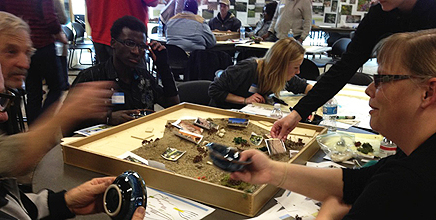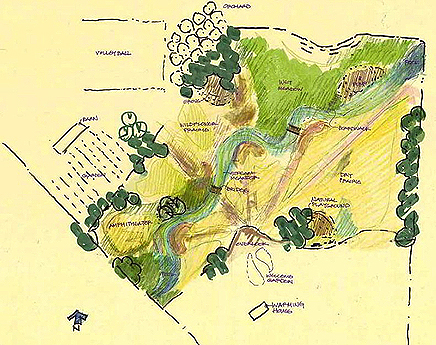The Fargo Project is a community collaboration to re-imagine the neighborhood storm water containment basins that dot the City of Fargo. The project focuses on redesigning an 18-acre detention basin at Rabanus Park in Fargo into a multifunctional recreational area that can serve as a model for how urban flood management infrastructure can be beautiful, engaging, and useful to different groups while maintaining its function as a storm water collection site. The project began with two years of planning involving the City of Fargo, environmentalists, artists, and community groups. The idea is to work with community to create a “community commons” that will reflect the internal life and cultural vibrancy of the city of Fargo.
The project began in 2012 by reaching out to the community through individual conversations, public presentations and community design events at churches, schools, West Acres Mall, neighborhood residents and business adjacent to the Park, conversations with new Americans from Bhutan, Sudan, Somalia, and Liberia; with Fargo’s Native American community, a public discussion with ethnobotanist and ecologist Linda Different Cloud, and talking with hundreds of people about the project at the Art on Ice exhibit at the Fargo Dome and with the Davies High School Art and Ecology Clubs. We invited people to imagine what they feel when they are outdoors or in nature and what they envision in an outdoor urban space. While there is still much to be designed and planned, community ideas have helped generate plans for natural playgrounds, an overlook, an amphitheater, wetland, dry prairie, wildflower prairie, bridges, and trails.
In order to learn what plants are already growing at the site, the city Parks District stopped mowing selected areas, revealing that the vast majority of the plants growing at the site now are native species, with only a small number of invasive plants. Because it is so innovative to be working in the context of a large storm water basin and because of the unique soils in the region, full-scale tests are being pursued during 2013 at the site to ensure success by understanding how the water, plants and soils will act once the concrete channel has been removed. Testing includes removing portions of the concrete channel, planting the surrounding areas with prairie seed mix, and shaping some small test mounds to help direct the water. Artists are working closely with Fargo City Engineers, Soil Conservation District, and NDSU natural resource researchers.








